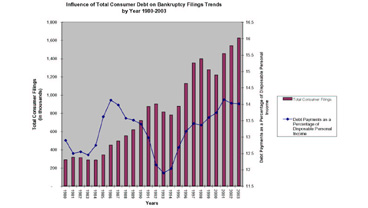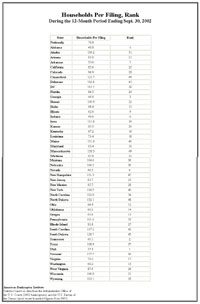|
Protecting America's Families: Predatory Lending
Contact: Stephen M.
Apatow
Founder,
Director of Research & Development
Humanitarian
Resource Institute (UN:NGO:DESA)
Humanitarian University
Consortium Graduate Studies
Center
for Medicine, Veterinary Medicine & Law
Phone: 203-668-0282
Email: s.m.apatow@humanitarian.net
Internet: www.humanitarian.net
United
Nations Arts Initiative
Arts Integration Into Education
Url: www.unarts.org
Twitter: unarts
Background
As
the real
estate market is credited for the rapid economic recovery, consumers
turned
homes into ATM's. Cash borrowed against home equity from 1990
through
1998 was calculated in the average range of 50 billion per year in
contrast
with the period from 1998-2002 where this figure rocketed to
approximately 300 billion per year. The time period from 1995-02
encompassed over a 33 percent real increase in house prices in contrast
with the boom periods of 1975-79 (approx. 17 percent) and 1982-1989
(approx. 18 percent). --
Jeff Rubin, CIBC World Markets, May 2003.
Conventional
loans to low-income buyers leapt 75 percent between 1993 and 1998.
Minority buyers increased at a pronounced rate, with blacks seeing 95
percent growth and Hispanics 78 percent. This growth in lower-income
and minority homebuyers helped fuel the ascent of the subprime mortgage
market, which grew at an eye-popping 880 percent. -- Predatory Lending: A Special Issue, Shutting the Door
on Abusive
Mortgage Practices: Bridges,
2001, The Federal Reserve of St Louis.
What
federal, state and municipal protections will be provided for
consumers, if real estate valuation is found to have been artificially
inflated, to an extent proportional to accounting irregularities that
fueled the stock market crash in 2002?
The Big Picture
Falls in world-wide
equity markets during 2000-2002 saw markets decline by US$13 trillion
or
US$2,000 for every man, woman, and child on the planet according to ABN
AMRO’s
Global Investment Returns Yearbook, a study of long-term investment
returns
by Elroy Dimson, Paul Marsh and Mike Staunton from London Business
School.
-- New research report finds stock market losses total
US$13 trillion since 2000.
A few
statistics to consider from "The
Ultimate Objective"
- The wealthiest fifth of the
world's people consume an astonishing 86 percent of all goods and
services, while the poorest fifth consumes one-percent.
- 32 percent of the population in
the developing world live below $1 per day (WDI). 2.6 billion people
lack
access to basic sanitation (UNICEF).
- In the last 50 years, almost 400
million people worldwide have died from hunger and poor sanitation,
That's three times the number of people killed in all wars fought in
the entire 20th
century. (BFWI) .
- Each day in the developing world,
30,500 children die from preventable diseases such as diarrhea, acute
respiratory infections or malaria. Malnutrition is associated with over
half of those deaths. (UNICEF, World Health Organization)
|
For global property markets,
the balance of risks is now shifting. With housing markets in about
two-thirds of the world either in or close to a bubble, the impacts of
the coming normalization of monetary policy cannot be taken lightly.
Courtesy of property-induced wealth effects, the global economy was
neatly able to sidestep the potentially devastating aftershocks of a
burst equity bubble. As the liquidity cycle now
turns, the odds are that the world will not be so fortunate the next
time
a bubble bursts. -- Global: Global Property
Bubble? (Part I), MSDW Global
Economic Forum, July 15, 2004. See
also: House of Cards: Survey-Property:The Economist, 29 May
2003. See: Housing and Housing Market Bubbles, NYU, Leonard
N. Stern School of Business.
In The
Spotlight
- House
keeping: Foreclosures Increasing, but homeowners have a lifeline:
"We’ve seen (mortgage) default rates
rise statewide, but an increase in (these) homeowners staying in their
homes," said Julie Fagan, director of the federal Housing and Urban
Development office in Hartford, Connecticut. Homeowners have a variety of
options to help them keep their homes when they have financial
struggles. New Haven Register, 24 January 2005.
- Contingency Planning: National Association of
Housing and
Redevelopment Officials: While home prices have largely kept
pace
with the general rate of inflation in the past, there has been an
unprecedented run-up over the last eight years, with the rise in home
prices exceeding the overall rate of inflation by more than 40
percentage points since 1995. This has created
approximately $4 trillion in bubble wealth - money that would not exist
if house prices had followed their usual patterns. Journal
of Housing and Community Development, October 2004.
- OFHEO
House Price Index Shows Largest One Year Increase Since 1970’s:
U.S.
House Prices Show Annual Rise of 9.36 Percent, September 1, 2004 For additional information, visit
the Office
of Federal Housing Enterprise Oversight News Center.
- How to Report a Complaint about Waste, Fraud, Abuse:
U.S.
Department of Justice. Are you
having trouble making your home mortgage payments? Are you facing
foreclosure
on your home? Get all the facts before you pay someone to help you work
out your mortgage problems. Check out the consumer alert on mortgage foreclosure scams. Gather all the information you need and do
comparative shopping when you need a mortgage. Looking for the Best
Mortgage? A Consumer
Information Brochure will guide you on what you need to know when
obtaining a mortgage.
- Predatory
Mortgage Lending: Current State
Laws || State Legislation || Federal Activities, National
Conference of State Legislatures.
Related Information
- Americans may have mortgaged future on high home
prices: We live in a hot real
estate market (median-priced homes in the Washington area rose 14
percent in 2003 to $286,000 and are up 57 percent since 2000), but we
aren’t all that different. Since 2000, the national median price for
existing homes has increased 23 percent to $170,000, and many gains are
much larger: 31 percent in Boston to $413,000; 64 percent in Los
Angeles to $355,000; 32 percent in Minneapolis-St. Paul to $200,000;
and 74 percent in West Palm Beach-Boca Raton (Fla.) to
$241,000. Robert Samuelson,
Newsweek, 21 April 2004.
- Housebound: According to Warren (Harvard Law
Professor) and
Tyagi over the last 25 years bankruptcies by families have risen by
more then
400 percent, by the end of the decade they project, one in 7 families -
many
headed by college educated professionals will have filed for bankruptcy
- Daniel McGinn, Newsweek, 15
September 2003 (PDF:
Harvard Law School).
- Ending the Foreclosure Crisis: Annual foreclosures
started in Chicago increased 74% from 1993 to 2001, from 4,927 to
8,556. Several community areas on the south and west sides
of the city experienced over a 300% increase in the number of
foreclosures started. There is a similar story from Cleveland where
foreclosures started increased 200% in the past four years. -- National
Training and Information Center. See also Predatory Lending Claims Available to
Borrowers in Foreclosure:
In handling mortgage
foreclosure cases in Illinois, a variety of defenses exist at both
at federal and state levels. The Illinois Technology Center for Law
& the Public Interest.
- Quantifying the Cost of Predatory Lending: U.S.
borrowers lose $9.1 billion annually to predatory lending practices
that include (1) Equity Stripping, (2) Risk-Rate Disparities, and (3)
Excessive Forclosures. A Report from the Coalition for
Responsible Lending, Eric Stein, July 25, 2001. -- Visit the Center for
Responsible Lending, a unit of the Center for
Community Self-Help (Self-Help), based in Durham, NC. Self-Help is one
of
the nation's leading community development lenders and has provided
$1.6 billion
in financing to help more than 24,000 under-served families own homes
or
small businesses.
- Bankruptcy/Mental
Health: U.S. Bankruptcy Court for the Eastern
District of North Carolina's web site.
Consumer Debt: Families In
Crisis
Bankruptcy Statistics: American Bankruptcy Institute
U.S. Bankruptcy Statistics
|
1994
|
780,455 |
1995
|
874,137 |
1996
|
1,125,006 |
1997
|
1,349,510 |
1998
|
1,398,182 |
1999
|
1,290,346 |
2000
|
1,217,972 |
2001
|
1,492,129 |
2002
|
1,539,111 |
2003
|
1,625,208 |
2004
|
820,433
(1st-2nd Quarter)
|
|
Consumer debt is consistent with bankruptcy filings
Research by the Federal Reserve indicates that household
debt is at a record high relative to disposable income. Some analysts
are concerned that this unprecedented level of debt might pose a
risk to the financial health of American households. A high level of
indebtedness among households could lead to increased household
delinquencies and bankruptcies, which could threaten the health of
lenders if loan losses are greater than anticipated.
|

|
Personal
Bankruptcy Fillings by Quarter
(click
on the image to view a larger version) |

|
|
Households
per Filings,
by State (Ranked)
(click on the image to view as
a PDF file)
|

|
.
.
.
|